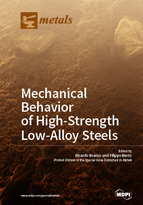Mechanical Behavior of High-Strength Low-Alloy Steels
A special issue of Metals (ISSN 2075-4701).
Deadline for manuscript submissions: closed (28 February 2018) | Viewed by 83592
Special Issue Editors
Interests: structural integrity; fatigue; fracture mechanics; finite element method; fiber-reinforced composites; environmental effects; additive manufacturing
Special Issues, Collections and Topics in MDPI journals
Interests: fatigue and fracture behavior of materials; mechanical characterization; structural integrity of conventional and innovative materials
Special Issues, Collections and Topics in MDPI journals
Special Issue Information
Dear Colleagues,
High-strength low-alloy steels are designed to provide specific desirable combinations of properties, such as strength, toughness, formability, weldability, and corrosion resistance. These steels are used in a myriad of engineering applications, namely highway and off-road vehicles, passenger car components, mine and railroad cars, construction machinery, industrial equipment, offshore structures, storage tanks, oil and gas pipelines, power transmission towers, and bridges, among others.
This Special Issue aims to address the mechanical behavior of high-strength low-alloy steels from different perspectives in terms of mechanical deformation, damage and failure under applied load. Papers dealing with processing techniques, modeling of the mechanical behavior, characterization of material microstructure, testing solutions, influence of environmental parameters, temperature dependence, as well as advanced applications are encouraged.
Prof. Dr. Ricardo Branco
Guest Editor
Prof. Filippo Berto
Co-Guest Editor
Manuscript Submission Information
Manuscripts should be submitted online at www.mdpi.com by registering and logging in to this website. Once you are registered, click here to go to the submission form. Manuscripts can be submitted until the deadline. All submissions that pass pre-check are peer-reviewed. Accepted papers will be published continuously in the journal (as soon as accepted) and will be listed together on the special issue website. Research articles, review articles as well as short communications are invited. For planned papers, a title and short abstract (about 100 words) can be sent to the Editorial Office for announcement on this website.
Submitted manuscripts should not have been published previously, nor be under consideration for publication elsewhere (except conference proceedings papers). All manuscripts are thoroughly refereed through a single-blind peer-review process. A guide for authors and other relevant information for submission of manuscripts is available on the Instructions for Authors page. Metals is an international peer-reviewed open access monthly journal published by MDPI.
Please visit the Instructions for Authors page before submitting a manuscript. The Article Processing Charge (APC) for publication in this open access journal is 2600 CHF (Swiss Francs). Submitted papers should be well formatted and use good English. Authors may use MDPI's English editing service prior to publication or during author revisions.







